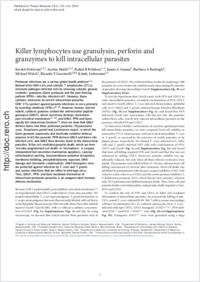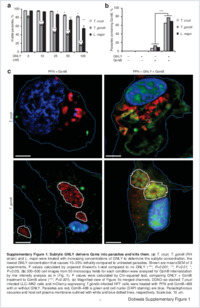Killer lymphocytes use granulysin, perforin and granzymes to kill intracellular parasites
- Dotiwala, Farokh Program in Cellular and Molecular Medicine, Boston Children’s Hospital, Boston, Massachusetts, USA - Department of Pediatrics, Harvard Medical School, Boston, Massachusetts, USA.
- Mulik, Sachin Program in Cellular and Molecular Medicine, Boston Children’s Hospital, Boston, Massachusetts, USA - Department of Pediatrics, Harvard Medical School, Boston, Massachusetts, USA.
- Polidoro, Rafael B Program in Cellular and Molecular Medicine, Boston Children’s Hospital, Boston, Massachusetts, USA - Fundação Oswaldo Cruz, Centro de Pesquisas René Rachou, Belo Horizonte, Brazil
- Ansara, James A Program in Cellular and Molecular Medicine, Boston Children’s Hospital, Boston, Massachusetts, USA
- Burleigh, Barbara A Department of Immunology and Infectious Diseases, Harvard School of Public Health, Boston, Massachusetts, USA
- Walch, Michael Department of Medicine, Université de Fribourg, Fribourg, Switzerland
- Gazzinelli, Ricardo T Fundação Oswaldo Cruz, Centro de Pesquisas René Rachou, Belo Horizonte, Brazil - Department of Immunology and Infectious Diseases, Harvard School of Public Health, Boston, Massachusetts, USA - Department of Medicine, University of Massachusetts Medical School, Worcester, Massachusetts, USA
- Lieberman, Judy Program in Cellular and Molecular Medicine, Boston Children’s Hospital, Boston, Massachusetts, USA - Department of Pediatrics, Harvard Medical School, Boston, Massachusetts, USA.
-
11.01.2016
Published in:
- Nature Medicine. - 2016, vol. 22, no. 2, p. 210–216
English
Protozoan infections are a serious global health problem1, 2. Natural killer (NK) cells and cytolytic T lymphocytes (CTLs) eliminate pathogen-infected cells by releasing cytolytic granule contents—granzyme (Gzm) proteases and the pore-forming perforin (PFN)—into the infected cell3. However, these cytotoxic molecules do not kill intracellular parasites. CD8+ CTLs protect against parasite infections in mice primarily by secreting interferon (IFN)-γ4, 5, 6, 7, 8, 9, 10. However, human, but not rodent, cytotoxic granules contain the antimicrobial peptide granulysin (GNLY), which selectively destroys cholesterol-poor microbial membranes11, 12, 13, 14, and GNLY, PFN and Gzms rapidly kill intracellular bacteria15. Here we show that GNLY delivers Gzms into three protozoan parasites (Trypanosoma cruzi, Toxoplasma gondii and Leishmania major), in which the Gzms generate superoxide and inactivate oxidative defense enzymes to kill the parasite. PFN delivers GNLY and Gzms into infected cells, and GNLY then delivers Gzms to the intracellular parasites. Killer cell–mediated parasite death, which we term 'microbe-programmed cell death' or 'microptosis', is caspase independent but resembles mammalian apoptosis, causing mitochondrial swelling, transmembrane potential dissipation, membrane blebbing, phosphatidylserine exposure, DNA damage and chromatin condensation. GNLY-transgenic mice are protected against infection by T. cruzi and T. gondii, and survive infections that are lethal to wild-type mice. Thus, GNLY-, PFN- and Gzm-mediated elimination of intracellular protozoan parasites is an unappreciated immune defense mechanism.
- Faculty
- Faculté des sciences et de médecine
- Department
- Département de Médecine
- Language
-
- English
- Classification
- Biological sciences
- License
- License undefined
- Identifiers
-
- RERO DOC 258966
- DOI 10.1038/nm.4023
- Persistent URL
- https://folia.unifr.ch/unifr/documents/304831
Other files
Statistics
Document views: 68
File downloads:
- wal_klu.pdf: 258
- wal_klu_sm.pdf: 119

